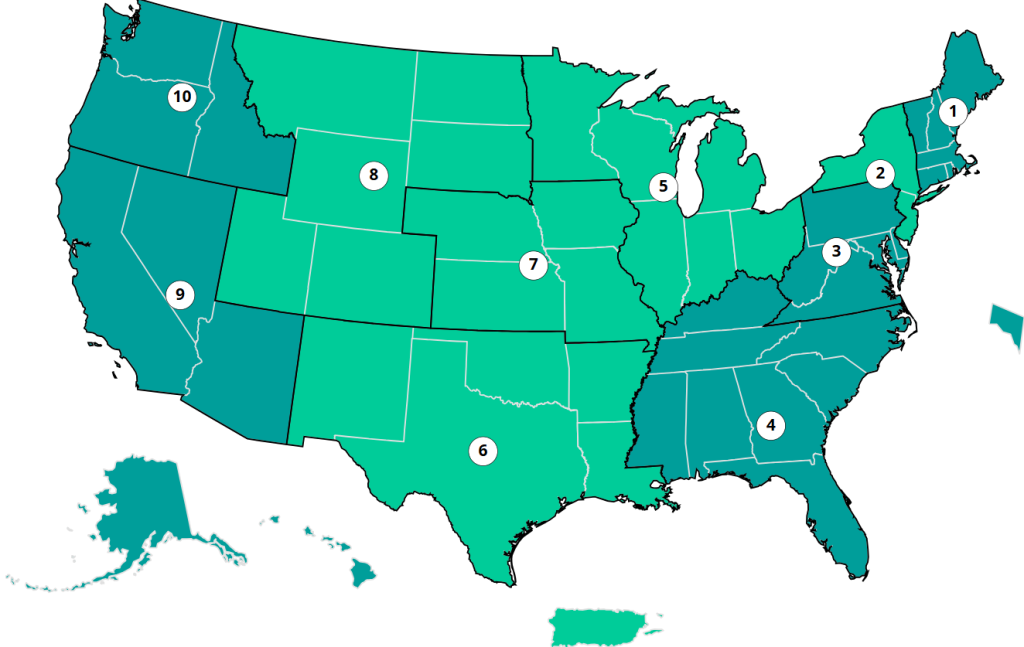As families prepare for holiday gatherings, the specter of COVID-19 looms once again, with new data revealing a shift in infection rates across the United States. For the week ending December 14, 2024, the national positivity rate ticked upwards to 5.6%, a slight increase from the previous week’s 5%. This rise underscores the continued circulation of the virus and the importance of ongoing monitoring efforts. Geographic variations in positivity rates are also apparent, with a cluster of states in the Mountain West and Midwest exhibiting the highest percentages, reaching 7.3%. This region, encompassing Wyoming, Utah, South Dakota, North Dakota, Montana, Colorado, Wisconsin, Ohio, Minnesota, Michigan, Indiana, and Illinois, suggests localized surges in viral activity. Other regions, including the South Central and central Plains states, also experienced elevated positivity rates, indicating a broader spread of the virus. Conversely, the Southeast, including states like Tennessee, South Carolina, and Florida, reported the lowest positivity rates, hovering around 2.3%. This regional variability highlights the dynamic nature of the pandemic and the influence of various factors, including vaccination rates, adherence to preventive measures, and the prevalence of circulating variants.
Complementing the positivity rate data, emergency room visits associated with COVID-19 offer another lens into the evolving situation. Nationally, 0.7% of ER visits were linked to COVID-19 during the week ending December 14. While this figure represents a small fraction of overall ER visits, it nonetheless signals the virus’s continued impact on healthcare systems. Similar to positivity rates, geographical variations in COVID-related ER visits are evident, with New Mexico reporting the highest percentage at 2%. Other states, including Kentucky, South Dakota, Indiana, New Hampshire, Arizona, Wisconsin, West Virginia, Maine, Kansas, Illinois, and Colorado, also experienced elevated proportions of COVID-related ER visits, ranging from 1.1% to 1.4%. These figures emphasize the need for continued vigilance and preparedness within healthcare settings, especially in regions experiencing higher viral activity.
Mortality data, while showing a decrease from the previous week, remains a critical indicator of the pandemic’s severity. During the week ending December 14, 254 COVID-19 deaths were reported nationwide, a decline from 335 the week prior, but notably higher than the 179 deaths reported in late November. This fluctuation in mortality underscores the complex interplay of factors influencing COVID-19 outcomes, including access to medical care, the presence of underlying health conditions, and the effectiveness of ongoing vaccination efforts. The CDC’s ongoing surveillance of wastewater for SARS-CoV-2 provides an additional tool for tracking viral spread. This method, which detects viral fragments shed in feces, offers an early warning system for potential surges in infections, even before they are reflected in clinical testing or hospitalization data. Currently, New Mexico, Kansas, and New Hampshire exhibit very high levels of SARS-CoV-2 in wastewater, while the national level remains moderate.
The resurgence of COVID-19 activity during the holiday season serves as a stark reminder of the virus’s enduring presence and its potential to disrupt daily life. Since the pandemic’s declaration in March 2020, the virus has infected hundreds of millions globally, claiming millions of lives. In the United States alone, over 103 million cases and 1.21 million deaths have been reported, underscoring the profound impact of the pandemic on public health. As winter approaches, the anticipated increase in COVID-19 cases highlights the ongoing need for preventative measures, vaccination, and continued vigilance in the face of evolving viral strains. The CDC recommends that everyone aged six months and older receive a COVID-19 vaccine during the current season (October 2024 to September 2025). This recommendation stems from the waning immunity provided by previous vaccinations and the emergence of new variants. Research consistently demonstrates the effectiveness of vaccines in reducing the risk of severe illness and death from COVID-19.
The latest variant of concern, XEC, a subvariant of Omicron, is believed to be more transmissible but milder than earlier strains. The emergence of new variants underscores the ongoing evolution of the virus and the importance of updated vaccines that target these emerging strains. The CDC’s list of current likely COVID-19 symptoms includes fever, chills, cough, shortness of breath, sore throat, congestion, loss of taste or smell, fatigue, muscle aches, headache, nausea, vomiting, and diarrhea. The overlap of these symptoms with other common illnesses, such as influenza, emphasizes the importance of testing to determine the specific cause of illness. Free at-home tests remain available for this purpose. Expert opinions concur that a winter surge in COVID-19 cases is likely. While this is a seasonal pattern, the combination of waning immunity, holiday gatherings, and the emergence of new variants necessitates continued caution and adherence to public health guidelines.
Looking ahead, the CDC will continue its comprehensive tracking of COVID-19 data, providing crucial information for informed decision-making. While a spike in cases is expected during the winter months, the severity of this surge will depend on various factors, including vaccination rates, the prevalence of new variants, and the public’s adherence to preventive measures. The availability of updated vaccines, coupled with continued monitoring and public awareness campaigns, provides tools for mitigating the impact of the anticipated winter surge. The lessons learned from past waves of the pandemic, combined with ongoing scientific advancements, offer hope for navigating this next phase of the COVID-19 challenge. The continued vigilance of individuals, coupled with informed public health strategies, will be essential in minimizing the disruption caused by the virus and protecting vulnerable populations.

